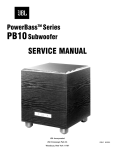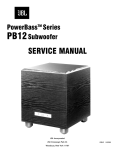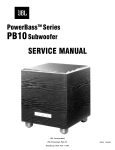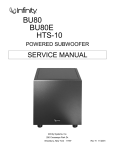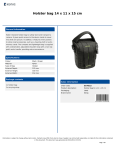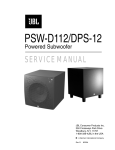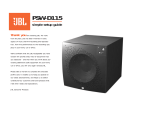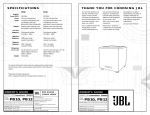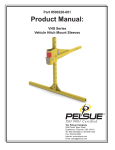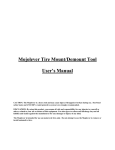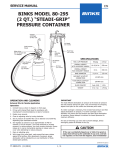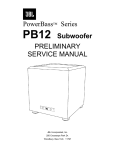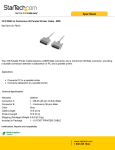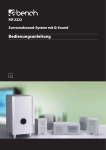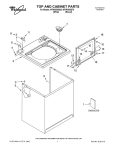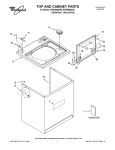Download JBL-PB-10-Service
Transcript
TM PowerBass Series PB10 Subwoofer SERVICE MANUAL JBL Incorporated 250 Crossways Park Dr. Woodbury, New York 11797 REV 0 7/00 PB10 TABLE OF CONTENTS Safety Information . . . . . . . . . . . . . . . . . . . . . . . . . . . . . . . . . . . . . . . . . . . . . . .3 Basic Specifications . . . . . . . . . . . . . . . . . . . . . . . . . . . . . . . . . . . . . . . . . . . . .4 Detailed Specifications . . . . . . . . . . . . . . . . . . . . . . . . . . . . . . . . . . . . . . . . . . .5 Controls and their Function . . . . . . . . . . . . . . . . . . . . . . . . . . . . . . . . . . . . . . . .6 Speaker Connection . . . . . . . . . . . . . . . . . . . . . . . . . . . . . . . . . . . . . . . . . . . . .7 Operation . . . . . . . . . . . . . . . . . . . . . . . . . . . . . . . . . . . . . . . . . . . . . . . . . . . .10 Troubleshooting . . . . . . . . . . . . . . . . . . . . . . . . . . . . . . . . . . . . . . . . . . . . . . .11 Test Setup and Procedure . . . . . . . . . . . . . . . . . . . . . . . . . . . . . . . . . . . . . . .12 Exploded and Packaging . . . . . . . . . . . . . . . . . . . . . . . . . . . . . . . . . . . . . . . .13 Amplifier Exploded View . . . . . . . . . . . . . . . . . . . . . . . . . . . . . . . . . . . . . . . . .14 Amplifier Faceplate . . . . . . . . . . . . . . . . . . . . . . . . . . . . . . . . . . . . . . . . . . . . .15 Integrated Circuit Diagrams . . . . . . . . . . . . . . . . . . . . . . . . . . . . . . . . . . . . . .16 Testing Procedure . . . . . . . . . . . . . . . . . . . . . . . . . . . . . . . . . . . . . . . . . . . . . .17 Electrical Parts List . . . . . . . . . . . . . . . . . . . . . . . . . . . . . . . . . . . . . . . . . . . .20 Printed Circuit Boards . . . . . . . . . . . . . . . . . . . . . . . . . . . . . . . . . . . . . . . . . .24 Schematics . . . . . . . . . . . . . . . . . . . . . . . . . . . . . . . . . . . . . . . . . . . . . . . . . .27 2 PB10 SAFETY INFORMATION 3 PB10 BASIC SPECIFICATIONS PB10 Subwoofer 4 PB10 DETAILED SPECIFICATIONS PB10 Subwoofer 5 PB10 PB10 Subwoofer Controls and their Function 1. Power - These lights will be red when the unit is plugged in and not receiving a signal; when the PB10 receives a signal, the lights will cycle to GREEN. If no signal is received after 10-15 minutes the lights will cycle back to RED (standby) until a signal is present again. 2. Level Control - The subwoofer Level Control, PB10, (located on the rear panel) adjusts the volume of the subwoofer relative to the rest of the system. 3. LFE/Normal Switch - Ordinarily placed in the Normal position - but switch to LFE when playing Dolby DigitaL, DTS or other digital surround modes - see page 9. 4. Phase Switch - Changes the subwoofer’s output to be in phase or 180 degrees out of phase with the program material. Front Panel Rear Panel 5. Crossover Frequency - Sets the highest frequency the subwoofer will reproduce. 6. Line Input - Main Input connection to subwoofer (preferred). 7. Speaker In Jacks - Main Input connection to subwoofer when line level, subwoofer, or pre-amp output connectors are not available, or when a high pass filter (set at 150Hz to main loudspeakers is desired through the Speaker Output Jacks. 8. Speaker Out Jacks - Connected to main loudspeakers when the Speaker Input Jacks are used. 6 PB10 Speaker Connection When we designed the PB10 and PB12 powered subwoofers, our goal was to offer the user the best possible performance combined with the most flexible and complete installation options. Please look over the following three examples to determine which description best matches your system and follow the corresponding hookup instructions. To use the binding-post speaker terminals with bare wire, unscrew the collar until the hole through the centerpost is visible under the collar. Insert the bare end of the wire through the hole in the post, then screw the collar back down until the connection is tight. The holes in the center of the collars are intended for banana-type connectors. Dolby Pro Logic (Non-Digital)-Speaker Level Use this installation method for Dolby Pro Logic applications (not Dolby Digital, DTS or other digital processing), where the receiver/processor does not have a subwoofer output or a volume-controlled preamp (line-) level output: back of your front left and right speakers. Connect your receiver or amplifier’s center, left and right surround-speaker terminals to the corresponding terminals on the back of your center, left and right surround speakers. Connect your receiver or amplifier’s front left and right speaker terminals to the left and right terminals on the subwoofer that are marked “High Level In.” Connect the left and right terminals on the subwoofer that are marked “High Level Out” to the corresponding terminals on the 7 PB10 Dolby Pro Logic (Non-Digital)-Line Level Use this installation method for Dolby Pro Logic applications (not Dolby Digital, DTS or other digital processing), where the receiver/processor is equipped with a subwoofer output or a volume-controlled preamp (line-) level output: Use RCA-type patch cords to connect the line-level subwoofer outputs on your receiver or amplifier to the linelevel inputs on the subwoofer. IMPORTANT: Make sure that the LFE toggle switch on the subwoofer is in the “Normal” position. Do not use the “LFE” position with Dolby Pro Logiconly processors. Note: If your receiver or amplifier only has one subwoofer output jack, then you may connect the subwoofer output on your receiver/preamplifier to either the left or right line-level input on the subwoofer. It makes no difference which jack you choose. Connect each speaker to the corresponding speaker terminals on your receiver or amplifier. 8 Make sure your receiver or processor is configured correctly; Make sure that the subwoofer is configured as “On.” Note for advanced users: If your receiver/processor has a built-in low-pass crossover filter for the subwoofer output, then the LFE switch should be set to the “LFE” position to bypass the subwoofer’s internal crossover. PB10 Dolby Digital or DTS (or Other Digital Surround Mode) Connection Use this installation method for Dolby Digital, DTS or other digital surround processors: IMPORTANT: Make sure that the LFE toggle switch on the subwoofer is in the “LFE” position. Use the line-level input jacks for the lowFrequency Effects channel. Connect these jacks to the LFE output or subwoofer output on your receiver or amplifier. Note: If your receiver or amplifier only has one subwoofer output jack, then you may connect the subwoofer output on your receiver/preamplifier to either the left or right line-level input on the subwoofer. It makes no difference which jack you choose. Connect each speaker to the corresponding speaker terminals on your receiver or amplifier. Make sure that you have configured your surroundsound processor for “Subwoofer On”or “LFE On.” 9 The front left, front right, center and rear speakers should be set to “Small” or “Large” depending on their size and frequency response. Consult your receiver’s or processor’s owner’s manual. PB10 OPERATION Power When the unit is plugged in and the LEDs on the front of the unit will turn red. When a signal is present, the LEDs will turn green. Note: It will take several minutes for the LEDs to turn from green to red after the input signal to the subwoofer is removed. Due to JBL’s unique, high-output, highefficiency amplifier design, power consumption is minimal when the subwoofer is not receiving a signal. The PB10 Level Control The subwoofer Level Control adjusts the volume of the subwoofer relative to the rest of the system. Proper level adjustments depends on several variables such as room size, subwoofer placement, type of main speakers and listener position. Adjust the subwoofer level so that the volume of the bass information is pleasing to you. Crossover Adjustments The Crossover Frequency Control determines the highest frequency at which the subwoofer reproduces sounds. If your main speakers can comfortably reproduce some low-frequency sounds, set this control to a lower frequency setting, between 50Hz-100Hz. This will concentrate the subwoofer’s efforts on the ultradeep bass sounds required by today’s films and music. If you are using smaller bookshelf speakers that do not extend to the lower bass frequencies, set the low-pass crossover control to a higher setting, between 120Hz-150Hz. This control is not used when the LFE switch is in the “LFE” position. 10 must be unplugged if you do not wish to leave it in auto (standby) mode. PB10 Phase Control The Phase Control determines whether the subwoofer’s piston-like action moves in and out in phase with the main speakers or opposite the main speakers. There is no correct or incorrect setting. Proper phase adjustment depends on several variables such as subwoofer placement and listener position. Adjust the phase switch to maximize bass output at the listening position. Remember, every system, room and listener is different. There are no right or wrong settings; this switch offers the added flexibility to adjust your subwoofer for optimum performance for your specific listening conditions without having to move your speakers. If at some time in the future you happen to rearrange your listening room and move your speakers, you should experiment with the phase switch in both positions, and leave it in the position that maximizes bass performance. TROUBLESHOOTING If you used the high-level (speaker) inputs and there is no sound from any of the speakers: If there is low (or no) bass output: •Check that receiver/amplifier is on and source is playing. •Make sure the connections to the left and right “Speaker Inputs” have the correct polarity (+and-). •Check that powered subwoofer is plugged into and active electrical outlet and is switched on. •Make sure that the subwoofer is plugged into an active electrical outlet and (PB12 only) switched on. •Check all wires and connections between receiver/amplifier and speakers. Make sure all wires are connected. Make sure none of the speaker wires are frayed, cut or punctured. •Adjust the crossover point. •Review proper operation of your receiver/amplifier. •Flip the Phase Control switch to the opposite position. •If you are using a Dolby Digital/DTS receiver or processor, make sure that the subwoofer adjustments on the receiver/processor are set up correctly. •Slowly turn the Level Control clockwise until you begin to hear the desired amount of bass. 11 If you used the line-level inputs and there is no sound from the subwoofer: •Check that receiver/amplifier is on and a source is playing. •Check that powered subwoofer is plugged into an active electrical outlet and is switched on. •Check all wires and connections between receiver/amplifier and subwoofer. Make sure all wires are connected. Make sure none of the wires are frayed, cut or punctured. •Review proper operation of your receiver/amplifier. •Slowly turn the Level Control clockwise until you begin to hear the desired amount of bass. •Make sure that you have configured your receiver/processor so that the subwoofer/LFE output is on. PB10 PB10 TEST SET UP AND PROCEDURE AC VOLT METER (6V) LEVEL FROM LINE-LEVEL SOURCE LINE LEVEL CD PLAYER Min Max LFE PHASE NORMAL 0 180 CROSSOVER FREQUENCY 50 Hz 150 Hz PRE AMP L PB10 or PB12 UNDER TEST R LINE LEVEL IN FOR LFE USE L or R L AMPLIFIER HIGH LIVEL IN R L SPEAKER OUTPUT FROM AMPLIFIER HIGH LIVEL OUT R 00229 SPEAKER LEVEL General Function UUT = Unit Under Test 1. Connect one line level input cable (RCA) from signal generator to either Right or Left Level input on UUT. VOLUME control should be full conterclockwise. 2. Turn on generator, adjust to 100mV, 50 Hz. 3. Plug in UUT; LED’s on the front panel may be either Red or Green. Turn VOLUME control full clockwise. Low Pass control should be set fully clockwise (150°). 4. LED should turn Green; immediately bass response should be heard and felt from port tube opening. 5. Turn off generator, turn VOLUME control fully counterclockwise, disconnect RCA cables. 6. Connect one pair of speaker cables to either high level input terminal on UUT. Cables should be connected to an integrated amplifier fed by the signal generator. 7. Turn on generator and adjust so that speaker level output is 1.0V, 50 Hz. Turn VOLUME control full clockwise. 8. Green LED should light, immediate bass response should be heard and felt from the port tube opening. Sweep Function 1. Follow steps 1-4 above, using a sweep generator as a signal source. 2. Sweep generator from 20Hz to 300Hz. Listen to the cabinet and drivers for any rattles, clicks, buzzes or any other noises. If any unusual noises are heard, remove driver and test. Driver Function 1. Remove driver from cabinet; detach + and - wire clips. 2. Check DC resistance of driver; it should be 5.8 ohms. 3. Connect a pair of speaker cables to driver terminals. Cables should be connected to an integrated amplifier fed by a signal generator and adjust so that speaker level output is 5.0V. 4. Sweep generator from 20Hz to 1kHz. Listen to driver for any rubbing, buzzing, or other unusual noises. 12 PB10 Exploded and Packaging Views 00223 5 4 2 6 1 7 8 MECHANICAL & PACKING PARTS LIST 3 1 10” Woofer 203400 2 Foot 203410 3 Outer Carton 203420 4 Owner’s Manual 120V 203430 5 Amplifier Complete 203450 6 Foot Screw 203411 Foam corners (package drawing): (IMAGE REDUCED) 13 7 Top Corner 4/carton 203460 8 Bottom Corner 4/carton 203470 PB10 Amplifier Exploded View 1 5 6 2 3 00225 4 LEGEND 14 1 Dual RCA jack 108324 2 Power Transformer 80135 3 Level Pot 40402 4 Low Pass Filter Pot 40707 5 Fuse Clips (2) 70323 6 1.25A SLO-BLO Fuse (3ag) 80114 PB10 Amplifier Faceplate Parts LEVEL KNOB 70313 LFE DEFEAT SWITCH 70150 PHASE SWITCH 70150 LEVEL Min Max PB10 FACEPLATE 70325 LFE PHASE CROSSOVER FREQUENCY KNOB 70313 NORMAL 0 180 CROSSOVER FREQUENCY 50 Hz L R LINE LEVEL IN FOR LFE USE L or R L HIGH LIVEL IN HI LEVEL I/O OUT 108116 R L STRAIN RELIEF 70305 HIGH LIVEL OUT R JBL INC. LR 110113 CSA 22-2 UL 1490 R NRTL/C 120V 60 Hz, 180W POWER CORD 80105 NORTHRIDGE, CA, USA CAUTION RISK OF ELECTRIC SHOCK DO NOT OPEN 00239 HI LEVEL I/O IN 108116 150 Hz 15 PB10 Integrated Circuit Diagrams S53AMI/S64AMI - Power Amp module SAFETY PART +6V 15 1 16 2 17 3 V+ NOTE: THE FOLLOWING PROCEDURES MUST BE FOLLOWED WHEN INSTALLING NEW S53AMI/S64AMI AMP MODULES: +6V FAILURE TO FOLLOW ONE OR MORE OF THESE STEPS MAY RESULT IN THE INSTANT DESTRUCTION OF THE MODULE WHEN POWERED UP. V+ 1. Align white indent marker on Amp Module with indent marker on main PCB; alternately observe position of label on top of the module; incorrectly replacing the Module 180° in the PCB slot will result in its destruction. 18 4 O/P 19 5 20 6 21 7 22 8 +15V 23 9 +15V SD 24 10 SD FR 25 11 FR I/P 26 12 I/P GND 27 13 GND -15V 28 14 -15V V- O/P 2. All AC powered test instruments (meters, oscilloscopes, etc.) must have a floating ground, i.e., be connected to an isolation transformer. V- 3. Align and position the Amp Module before soldering. 5. Use only rosin-core or non-acid core solder; thoroughly de-flux the surfaces after soldering. 00228 If the new S53AMI/S64AMI Amp Module has larger mounting hole(s) in the case, and the stock screws no longer will fit, and screws of the proper type cannot be obtained locally order: (2) part# 60301S (screws) (2) part# 60301N (nuts) Q10,Q11 (MPSA56) N-Chan JFET Q1 Q12 (2N4401) 3 Collector 3 Collector 2 Base D S 1 G 16 2 Base 1 Emitter 2 3 1 1 Emitter 2 3 00227 U1,U2 (Lm324, TLO64)) 4. Attach the amp Module with the mounting screws before soldering or powering up. PB10 PB10 Testing Procedure 17 PB10 PB10 Testing Procedure (Cont.) 18 PB10 PB10 Testing Procedure (Cont.) 19 PB10 PB10 Electrical Parts List PB10 POWER AMP section of PCB Version 6.3. Part # Designator Description 20 PB10 PB10 Electrical Parts List (Cont.) PB10 POWER AMP section of PCB Version 6.3. Part # Designator Description 21 PB10 PB10 Electrical Parts List (Cont.) PB10 POWER AMP section of PCB Version 6.3. Part # Designator Description 22 PB10 PB10 Electrical Parts List (Cont.) PB10 PREAMP section of PCB Version 6.3. Part # Designator Description 23 PB10 PB10 PCB’s 24 PB10 PCB’s (Cont.) 25 PB10 PCB’s (Cont.) 26 PB10 Schematics 27 PB10 Schematics (Cont.) 28




























